Welcome to RennTech.org Community, Guest
There are many great features available to you once you register at RennTech.org
You are free to view posts here, but you must log in to reply to existing posts, or to start your own new topic. Like most online communities, there are costs involved to maintain a site like this - so we encourage our members to donate. All donations go to the costs operating and maintaining this site. We prefer that guests take part in our community and we offer a lot in return to those willing to join our corner of the Porsche world. This site is 99 percent member supported (less than 1 percent comes from advertising) - so please consider an annual donation to keep this site running.
Here are some of the features available - once you register at RennTech.org
- View Classified Ads
- DIY Tutorials
- Porsche TSB Listings (limited)
- VIN Decoder
- Special Offers
-
OBD II P-Codes - Paint Codes
- Registry
- Videos System
- View Reviews
- and get rid of this welcome message
It takes just a few minutes to register, and it's FREE
Contributing Members also get these additional benefits:
(you become a Contributing Member by donating money to the operation of this site)
- No ads - advertisements are removed
- Access the Contributors Only Forum
- Contributing Members Only Downloads
- Send attachments with PMs
- All image/file storage limits are substantially increased for all Contributing Members
- Option Codes Lookup
- VIN Option Lookups (limited)

ciaka
-
Posts
469 -
Joined
-
Last visited
-
Days Won
14
Content Type
Profiles
Events
Forums
External Paint Colors
Downloads
Tutorials
Links Directory
Collections
Store
Posts posted by ciaka
-
-
Gents, here are my old pipes for you to stare...lol. Still waiting for oem hose Ts to arrive, so I can put it all together, but at least got to the leak. There was some coolant in the valley, but some told me their large T burst resulted in coolant in valley too. I hope he is right. In mean time, let me know if you spot anything i should be looking at replacing in pipes area (seals, misalignment, etc). Thank you.

-
If you know headlight is 2 years old only, swap the ecu. Do not assume it is ok. Proper troubleshoot will allow to look at all aspects, no matter how unlikely.
If you swap out ecus left to right, and drive and the other headlight starts acting up, you just found out ecu is bad without having to spend couple hundred bucks on a new one for a guess.
Dont give up, you will get it. Good job.
-
Here are my new replacement Ts, from JagsThatRun.com. They charged me $24 per each T, shipping $10 to country of Texas, total $58 delivered within about 4 days total. So turn around was super quick and I am super happy.
Also ordered OEM hoses that include the plastic Ts. Will remove hoses from those Ts, and install on the metal ones for installation onto the car. Then will do the pressure test again to make sure no other leaks are there, and then onto putting all back together.
Ordered from here in case you have same issue.

-
3 hours ago, Dino Roussetos said:
I took both headlights out, brought them indoors (-20 Celsius), cleaned the connectors, cleaned the contacts for both indicator bulbs, slapped them back in, and viola! worked until an hour later, bummer, right indicator failed. I will have to wait until milder weather to look at the harnesses and assess..good information thx!
The harness to assess is the one inside the headlight itself. Once you open cover, look down, all the wires coming out of that connector (which mates with harness outside headlight), most get brittle and flake off due to heat/age.
-
...so, have intake off, pressurized system, found leak. Large T. Still puzzled why some coolant was in valley of engine. Could the large T breach and spray some into it?
Aluminum Ts and OEM hoses already on way. Thinking of replacing O rings on pipes just in case but few folks told me they will be fine if recent (which they are). So split on that decision. Was also thinking reseat thermostat pan, but it looked dry there and feeling under the coolant pipes going to thermostat I did not feel any moisture on fingers, and did not see any moisture on pipes with a plumber snake camera.

-
19 hours ago, nerdtalker said:
When my coolant Ts blew up (the two to the back right of the engine against the firewall) yes there was coolant sprayed everywhere, and some made it into the V of the engine. There's also that bleeder hose which is prone to becoming brittle and cracking which would dump coolant there, although yours looks ok.
Are you talking about the long thin, black hose looking like a number 4, going from rear of engine bay, to front of it, connecting to each side of the intake? That one was replaced by the repair shop about 2 years ago. Contemplated replacement, but touching it, does not appear brittle at all.
Now, I am looking for a place where I can order all the o rings and rubber pieces for the coolant pipes, plus gasket for thermostat housing. Dont need pipes, just the seals/gaskets.
-
Last week went into the garage, and saw pool of coolant under the driver seat area on garage floor.
Now, thinking it could be the T connections (two of them, one small T and another large T), that are plastic, extremely hard to get to, and fail routinely.
Took the intake out, looking in and observed some coolant near/under the starter area (under left or pass. bank of cylinders), under the pipes near the thermostat area, also see some coolant under the right bank of cylinders, inside the V of engine.
Did not really see much wetness near back where the T connectors are.
Planning to do a pressure test when my tool comes in (hoping tomorrow).
Looking for folks to look over the pics/vid, and tell me if they see suspect info that can make PD easier or direct to an area.
Placed my pics on google drive HERE. Look through (sorry, was taking valves condition pics too, while i was there, seem to look good).
Thank you for help. -
From my experience on CTT headlights there are a couple places to look.
1. Harness - #23 on parts diagram. Simple to replace. Sometimes resolves issues.
2. ECU - #17 on parts diagram, mounted on bottom of headlight assembly. Simple to replace with Torx bit. This one would cause dipped headlight errors if it craps out.
3. Internal wiring of headlight connector that mates with #23 harness.
This one, item 3, is most likely why folks get errors etc. After years of working, the wiring insulation becomes brittle, and starts flaking off. Combined with the fact that folks replace bulbs often through life of car, moving wires, accelerating the insulation flaking off process.After some time, the wires become exposed and that is when you start seeing all sorts of funny stuff happen. Battery discharged, components not work, fuses blowing, etc.
I looked into there and the only way to solve is the replace the internal headlight connector, or buy new headlight. I was unable to find any part or process for replacing only the connector. Dont want to spend 500 bucks on new headlight, so what I plan to do is do slight modification of internal headlight, to access internal wires, and replace each wire with new wires, that will be heat shrink tubed to ensure no wires touch. Started doing this but now playing with a different issue, putting the headlight one on back burner.
If you want to eliminate the dipped beam due to the ecu for it (#17), remove both headlights, and swap the ECU, the dipped beam will follow the bad ecu. I did that and had to order another ecu. Once in, all was great. However, I challenge all of you to take out headlight, open the covers, and look inside the headlight at the small wires as near the inside of headlight connector as you can. You will see all sorts of cracking on wires there - that is the source of many issues electrically here.
-
yep, Panameras do get noisy after some miles. Same with Cayennes, and other Porsche cars (this issue not unique to Porsche though).
Knocking typically gets eliminated by changing lower control arms and/or upper control arms (these very hard to see until removed - bushings obstructed by mount points to chassis).
Mattress spring like noises usually eliminated by sway bar bushing replacement and/or sway bar links replacement.
Full alignment is very much recommended any time you do suspension work that involves detaching suspension components.
-
I plan to remove intake to pd coolant leak that recently occured on my cayenne turbo.
Have few questions and advice from those in the know. Thank you very much.
My CTT had coolant pipes done already and replaced with the metal ones. Yet, another coolant leak happened so deciding to do on my own since mechanic obviously either did job wrong, or neglected to tell me of some other part that fails routinely, and now I have to take this apart again.
1. Do I need to get new intake seals (two of them) whenever removing intake on cayenne turbo
2. In addition to cooling pipes, what other pipes routinely fail under the intake, so I can keep an eye out.
3. Are there parts I can get that have longer life, so I dont have to redo yet again.
4. Any ohter advice while doing this for my car (tips, hints, items worth changing while you are there, etc)
5. Heard there are some smaller pipes that are plastic but fail, and can be purchased metal (not sur if t-pipe or angled, etc), but if you have info withg pn, url, I will really appreciate it.
thank you. -
DIY:Porsche logo door courtesy light swap
This is probably the easiest mod you can do for the car. I am actually surprised it came out really nice. You end up having a nice Porsche logo projected on the ground, directly below the doors, as you enter the car. Total cost was $28 dollars shipped, and maybe 5 minutes of time to install. Enjoy.
-
Author
-
Category
-
Submitted01/20/2019 10:39 AM
-
-
DIY: Steering Knuckle / Wheel carrier removal for bearing replacement
Before I started, I called around and found a shop that has a press and many adapters, so they can press out wheel hub from wheel carrier, then press out the bearing, then press in new bearing and finally press in old wheel hub. Shop I found did it for me, charged me 20 bucks, 20 minutes. Below shows you what you need to remove to get to the wheel carrier, so you can take it to shop and have bearing replaced. Hope this helps out. You would want to do this if you notice noises in car
-
Author
-
Category
-
Submitted01/18/2019 08:24 AM
-
-
DIY: Steering Knuckle Bearing Repacking
Before you install new bearing into the knuckle, it is recommended you repack the grease. Why? The oem grease is about 200˚F. Repacking with high pressure and high temp (800˚F - CV-2), will ensure max protection. This will be part of my diy for replacing bearing, but making this separate in case folks do on their own too.
-
Author
-
Category
-
Submitted01/15/2019 11:21 AM
-
-
My guess, without diagnostics, you may have air shocks leaking air and they do not get raised high enough to tell car it is at proper level for driving.
Regardless of mileage, rubber starts leaking.
Put your car into normal mode, and see if it appears low (front and/or back wheels very close to well edges). If yes, definitely shocks.
You will need to open hood, unscrew the triangle covers that cover shock tops on each side, use soapy water to find if top of shocks/connectors are leaking air. Bubbles will tell you they are.
I have DIY threads on air suspension which you should find and read to help understand.
Also, if this is not air shock related, it may be PDCC related. Do you have messages on cluster with more detail?
Hope this gives you starting point. Thanks.
-
I know. Been looking for a while.
ONce I saw them for sale but yellow. Dont remember where. ECS? Suncoast? dunno.
-
Anyone know what the part numbers are for the guide pins, that get screwed into calipers? They are what the front pads travel on (the pins go through the holes in the brake pads).
If rear ones exist too, I would love the PNs.
And if you know of a place to buy, man, you will make my day.
-
IMO (and it is, my opinion only), the latest rev of the Panamera looks like an older audi, not popping at all. Removed anything that could make it stand out, and made it criticism safe. Poor choice IMO, and a negative move. I now like the prev gen look much more.
-
DIY: PDK Transmission Factory Reset Procedure
If you buy your car pre owned, or if it went into limp mode, or you just think you have some quirks in it, one way to diagnose or pd if you have issues, is to try reset the PDK itself. The car learns driver habits over time. After a few years, a new owner may have different driving style, and this reset will help the new owner get car into factory condition, so it can learn new owner habits and hopefully be a better experience for the new driver. Below pic is from Porsche, and gives 4 ste
-
Author
-
Category
-
Submitted11/07/2018 08:34 PM
-
-
DIY: Panamera Oil Change
I did not bother to do a DIY for oil change, because there are some vids out there on how to perform this work. Below is a link to one of these videos, will walk you through the complete oil change. Items I used: - Oil: Castrol Edge full synthetic 5W40 - purchased 10 quarts, will use about 9 or so - Oil Filter: Mahle OX 254 D4 - replace this part every time - Drain plug: 900 219 020 31 - if you are gentle and do not screw up the hex hole in the plug, you can re use the plug. Be gent
-
Author
-
Category
-
Submitted10/28/2018 09:49 AM
-
-
Removing Stuck Ignition Coil Rubber Boot
Here is something that I think will help many here. One of the maintenance tasks I did was replacing coils and plugs. Easy enough. After replacing the parts, and while tightening the eTorx ignition coil bolts (aluminum), I was not careful and snapped bolt on cylinder 3. BTW, its 3ft/lbs +90˚ (but with SMALL wrench, not 3/8) Since coils sit there pretty well, I left it as is until I got the bolt and had time to remove/replace (I do have some tips for removing the snapped part of the bol
-
Author
-
Category
-
Submitted09/23/2018 05:41 PM
-
-
Panamera Air Shock Replacement (Front)
After doing some work on my PTT, i put this DIY together to help others replace their own shocks. Ended up replacing both front shocks. Then, one of replaced shocks was not working. Once I figured that out (info about how to diagnose is in the air suspension info thread), company overnighted another replacement (I pre paid, and they refund money afterwards -takes about 2 weeks after they get shock back). Doing first shock replacement took about 4 hours with pics, breaks, etc. Doing
-
Author
-
Category
-
Submitted09/20/2018 10:33 AM
-
-
Panamera Upper Control Arms Replacement
If your car is making clunking, squeaking noises while going over bumps, it is very likely that your upper and/or lower control arm bushings are damaged. It is very hard to determine if upper control arms are damaged, because the bushings are mounted in such way, which prevents inspection (bolts/chassis are in the way of visual inspection). Rest assured, if you are clunking over bumps, and your upper control arms are more than 60k miles old, it is time to replace them. Some have reported these
-
Author
-
Category
-
Submitted09/12/2018 09:14 AM
-
-
NOTE: This is in progress of being edited to add pics/info. This line will be removed once final.
My recent decision, to proactively fix a small leak on my PTT, turned into a full air suspension debug session.
I learned many useful details, which I hope you can keep in mind, when your car starts exhibiting air suspension issues.
Troubleshooting the air suspension is not super difficult, but it really helps to understand all components, and how they work together to keep the Panamera performing at its peak.
Terms below and ordering mostly match terminology in the FSM, to help reduce ambiguity.
First – overview of the entire air suspension.
Look over the entire diagram and identify each of the components shown, so you can get a good feel for where each part is, how it connects to the rest of the system, and how the entire system is supposed to work as a unit.
PANAMERA AIR SUSPENSION COMPONENTS

Panamera air suspension is made up of the following pieces, which all must work well, in order for the suspension to work appropriately.
-
Air shocks, front – air strut for front of car
There are two front air shocks, which have internal cavities, where compressed air is injected, to raise the car higher, lower it, make shocks stiffer, etc.
These front air shocks have rubber bladders, where the air is injected, to achieve desired function. These air cavities are made of rubber material, which, after few years, will deteriorate, and can start leaking air. The air can start leaking from the rubber material (bellows), or can lead out of the top of the shock, or the upper shock bushing. Leaking from bellows will not be easy to observe as they are mostly obstructed by the shock components. Leaking from upper shock bushing can be observed by spraying soapy water onto the top of the shock. Leak will manifest itself by soapy water making bubbles on top of the shock. The air shocks have 3 connections on the top side of each: Air line/tube (off center, different color for each shock), air shock sensor at center top of shock (detects shock expansion/compression with air), and electrical connection for valve that lets air in/out of the air shock (right near the air line). The air line connects to the air shock via a brass fitting, which ensures air tight connection between air line and shock. The sensors and electrical connections are connected to the ECU, so it can tell position of each corner, and adjust as necessary, or can turn electrical connections on/off, to control flow of air into/out of shock. Each air shock has a pressure regulated valve on it, making sure that there is some small amount of pressure in the tank at all times, to help prevent damage to the shock internals if it gets compressed hard (as in after new one put in and car is lowered onto new shock).-
Air shock
-
-
Air shock connectors
-
-
Air shock
-
Air shocks, rear – air strut with spring for rear of the car
These rear air shocks are similar to front shocks, but these reservoirs are separate from the struts that help support the car. The air bellows help raise or lower the car just as the front air shocks. Rear air shocks are assisted by vibration dampers mounted to the side of each shock. Same connections go to the top of each air shock for rear: Air line (different color for each side), electrical connection for valve in the shock, and sensor that detects if shock expands/compresses when air is adjusted.
The sensors and electrical connections are connected to the ECU, so it can tell position of each corner, and adjust as necessary, or can turn electrical connections on/off, to control flow of air into/out of shock.
Each air shock has a pressure regulated valve on it, making sure that there is some small amount of pressure in the tank at all times, to help prevent damage to the shock internals if it gets compressed hard (as in after new one put in and car is lowered onto new shock). -
Vibration dampers for rear axle
These vibration dampers help rear shocks in absorbing chassis movements, making the rear stable while driving. -
Level sensors
There are four sensors, each mounted on the upper control arm near each shock. These sensors detect if the corner of the car was raised or lowered, or if the particular corner of car is outside the ‘typical’ position (too high or too low). These sensors are responsible for error messages like ‘vehicle is extremely low’, etc. The sensors have one electrical connection, and two arms joined with an elbow that allows movement when car goes up or down. These sensors are connected to the ECU, so it can detect each corner position and adjust as necessary. There are additional sensors mounted on top of each air shock. These sensors detect the inflation/deflation of each shock, and can tell the ECU if the shock how much air is in each shock (so ECU knows if the suspension is stiff, loose, etc).-
Level Sensor
-
-
Level Sensor
-
Air Compressor
Sometimes this is called the air pump. This compressor is located under the car, behind the rear differential, under a protective shield. This compressor compresses air, and feeds it into the air tank. Its sole job is to make sure the air inside the tank, is at predefined pressure, so that the suspension can be adjusted quickly, per design. The Air compressor is connected to the ECU via electrical connections. It also has a filtered line coming out of it (see the pigtail in diagram, coming to the left and ending with a round structure). This round structure is an air filter, making sure clean air goes into compressor from outside, so it can be compressed and forced into the air tank. This compressor is also connected with a color coded air line, to the air tank itself. -
-
Valve block
Sometimes this is called valve body or valve unit. This valve block is a group of solenoids, which, when energized (connected to electricity), perform some type of work. The work they do is simply to open a valve, allowing compressed air to either go into a shock, out of a shock to be vented out through a dedicated OUT connection on the block itself. This OUT connection is a plastic pipe which ends under the trunk near the bumper. When air is let out of shocks, the compressed air travels out of shocks, through the air lines, into the valve block, and through the OUT port, into the vent line, and is let out of the system (this is the muffled hissing sound you hear when your car is lowered). Normally, the valve block is not energized, and all valves are closed (no air is moving through the block). For any valve to be open, that valve must get powered from ECU, and corresponding solenoid is energized, opening the paired valve to allow air through. As soon as ECU removed electricity, the valve closes automatically. The valve block has an electrical connection that connects to the ECU. The ECU controls the opening/closing of each valve/solenoid in the block, when inflating or deflating each shock. -
-
Air tank
Sometimes called the pressure accumulator (because it accumulates or collects compressed air). This is simply a metal tank, where compressed air is stored, so that when necessary, each shock can be inflated quickly. This air tank is connected to the air compressor with one line, and to the valve block with another line. Compressor feeds compressed air to the air tank, and if needed, air tank provides the system with compressed air via connection to valve block. -
ECU or Leveling system control unit/PASM
This is the ECU or the leveling system control unit. It is a circuit board with electronics, that will turn on/off power to pieces of air suspension, will monitor sensors in the system, monitor position of each corner of car. This is the brain of the entire system. Issues with ECU, issues with detecting various sensors by the ECU, result in errors such as the air suspension system failure, etc. This ECU is connected to each shock, each shock sensors (monitor if inflating/deflating), each shock sensor near upper control arm (control height of the vehicle body), connected to valve block, controlling open/close of each solenoid/valve in the valve body, and is connected to the switches inside the car, the ones you press if you want to raise the car, make shock stiffer or softer, want to go into sport or sport plus mode, or back into the default comfort mode. -
Switches inside the cabin to adjust suspension
These are the switches that you use to change the configuration of air suspension in your car, higher, lower, comfort, sport, sport plus, etc
OPEN OR CLOSED AIR SUSPENSION SYSTEM
Now, few things about the system, as I learned while debugging, and after speaking to mechanics that work on Panameras.
FSM states this is a closed system. Porsche mechanics would tell you it is a closed system.
Indy shop mechanics would tell you it is not a closed system.
I think the discrepancy is in the way you view the system itself. The shocks and valve block and air tank compose a closed system. Once pressurized, air remains in shocks and lines. When shocks are lowered though, they let air out of the system, through valve block, through the OUT port on the valve block, into tubing that vents air under the car behind the bumper. Similarly, the compressor draws filtered air from outside, and compresses it for the air tank.
So you can look at this system as a closed system (shocks, valve block, air tank only), or an open system, if you include the compressor and the OUT vent line from the valve block.
Whichever way you look at it, just be aware of how things work and you will be fine.
TYPICAL SYSTEM OPERATION
Now, lets go through typical operation of the air suspension system in the Panamera. This assumes car is working perfectly fine, no issues with suspension.
You get into the car in the morning. Car has been standing there overnight. Lets assume it got cold over night. Once you get in, car knows via sensors driver has just gotten into car.
You turn on the ignition and start the car. Sensors at center of each shock, and near upper control arms, tell the ECU what position the car is in. Car knows its last position from night before, when you parked the car.
So if for some reason (cold weather), pressure in any part of the suspension was decreased, after car is started (and all doors closed), the ECU will determine if the air tank needs to be pumped up to proper pressure.
If not, all good to go. If air tank pressure is a little low, compressor kicks in (relay in trunk of car will energize, and will close connection to turn on the compressor). The compressor will keep running on a timer and/or the
temperature sensor, and on a pressure in tank sensor. Once compressor starts, it will shut off if it becomes hot, or if the pressure in air tank reaches desired pressure, or if the compressor runs for more than a couple minutes.
The compressor stops because ECU disconnects electrical connection to the relay in trunk, removing electricity to relay, and therefore removing electrical connection to the power circuit that energizes the compressor.
Then, compressor stops running.
Once air tank is at pressure, ECU has already sensed how high your car is, how inflated or deflated your air shocks are. If the car is too high, air can be let out of the system to return to position dictated by switches in cabin.
If car is too low (got very cold outside), the ECU turns on all necessary solenoids/valves in valve block and in shocks, to allow compressed air to travel from high compressed area (air tank), to less compressed area (shocks).
Sensors in shocks will tell the ECU when to turn valves off, when proper height or stiffness is reached.
WHAT CAN GO WRONG, HOW TO DETECT & DEAL WITH REPAIR
Now, how does this system fail? Actually, very simple. You can divide it into 2 categories. Electrical (connections, sensors, ecu, etc), and mechanical (components, connections, lines, etc).
Shocks
If air shocks have leak in them (internally or at top of dampers for fronts), air will leak out, causing ECU to detect lower position of shocks, then making air compressor to work so the positions can be corrected.
If the leak is bad enough, the compressor will be asked to turn on way more often, causing it to heat up. If enough heat gets into the system, the air compressor piston/seals, etc can get broken, making compressor bad and
requiring either recondition kit with new pistons and seals, or a purchase of another compressor.
If there are leaks in the shocks themselves, the shocks have to be replaced. There is no way to repair these shocks on your own, since that would require disassembly of each sock, in a way that cannot be put back together again.
Special presses are needed to seal the shocks. So only way to fix leaking shocks is to buy new ones. You can get OEM brand new ones, or remanufactured ones. Many have found remanufactured shocks to be good fit, as price is about 30-40% of new OEM ones,
and they can work for very long time too. Choice dictated by your sense of what you need/prefer to get.
Air lines
You can also experience leaks in the air lines themselves. After years of use, a line can crack, causing leaking to occur from the shock itself (valve block is normally all closed, so any compressed air will leak out of the shock).
I think it is hard to crack air lines, unless work in the area on the car resulted in air lines being twisted, or pinched or forced, in a way to cause a crack. Near the shock connections in engine bay, it gets hot, so I can see these connections becoming brittle,
and cracking a bit. In these situations, you have to buy new air lines, or try to patch a found leak with epoxy, etc.
A good way to check if air line is leaking, is to disconnect from shock, and pull vacuum on it, while other end is connected to the valve block, and assuming valve block connection or internals are not leaking as well.
Then, you should see vacuum hold in the line. Otherwise the line has a leak and must be dealt with. Not fixing this will cause low pressure in shock all the time, making compressor over work, and being broken eventually.
Level sensors
Sometimes the level sensors near, or on the shocks, will become defective. This is usually manifested by the system not being able to detect that one or more shocks has been raised or lowered, or if stiffness has changed inside a shock.
If a level sensor goes bad, after button is pressed to raise car, you can see car raising, but can see messages on cluster that the system is faulty. Another example is changing modes to sport or sport plus, and ECU saying
on cluster air suspension system fault, or inability to enter the mode. As side note, if you cannot enter sport or sport plus mode, you will usually see other errors on console, along with limiting car power.
Car thinks something bad going on with suspension when trying to enter sport or sport plus mode, and will disable these modes based on errors. These additional errors normally go away after issue is fixed.
Normally, if level sensors go bad they will need replacement. Repair is a diy thing and often sensor is junk when broken.
Air compressor
Yet another common failure is the air compressor. This device makes sure the air tank is always at correct pressure, so that suspension changes can be done quickly (they say under 4 seconds).
If there is a leak in suspension, the air tank is asked to refill shocks much more often. This results in compressor working much more often to keep the air tank refilled.
You can start your car, close all doors, and stand by passenger side muffler. Listen for low tone humming coming out. That’s the compressor. If you hear it coming on often over 20 minutes of idle, you have suspension issues.
You can troubleshoot compressor issues by codes. Normally suspension system failure can manifest as bad compressor. If you do not hear compressor kick in at all when you press button to raise suspension, chances are, compressor bad.
If you hear mechanical sounds that sound other than an electrical mattress inflator, you can suspect compressor.
Sometimes the relay goes bad, which typically will manifest as compressor not kicking on at all, or compressor being on all the time (this one usually results in relay bad).
Any time you replace compressor, replace relay as well. This ensures bad relay does not damage new compressor too. New relays have been changed slightly, altering voltage and current they can provide through them, to help compressor.
Valve block
Another place common to fail, is the valve block itself. Age can cause pressure fittings on any of the air lines to valve block, to become leaky. Then you can purchase these air fittings and replace in the valve block.
Problem with that is that often the block starts leaking internally too. Most of the time, the entire valve block is replaced. New one comes with fittings too.
To detect if valve block connections leak, you spray soapy water onto the air lines and fittings, and you would see air bubbles coming from fittings. You cannot test internal failures unless valve block itself becomes bad.
In this case, some valves will become stuck, manifesting in one corner being stuck low or high, or maybe all corners stuck in one position, despite using buttons to try switch to different configuration.
If only one corner is stuck, maybe two, chances are block needs replacement.
Air tank / pressure accumulator
It is hard to envision air tank failing, but it is possible something wrong with the lines makes the tank work bad. Not many things can make tank go bad, except for some puncture making leaks in tank, or lines.
ECU / Leveling system control unit
If the ECU goes bad, the entire system is no longer being monitored or controlled. This means your can wont raise, wont lower, wont change any settings for shocks, etc. The brain of the suspension is dead.
Therefore the entire suspension is dead. If nothing happens when you press any buttons, and compressor does not kick in, and car does not change height, but car has not slammed down (corners do not appear deflated),
it is a good sign the ECU is the problem.
Switches inside cabin
If you press buttons to change height, change mode, etc, and nothing happens, you can suspect the switches in the cabin. Usually one or two will not work, but other will. It is unusual for all suspension related buttons to stop working at same time.
If you can change modes, but cannot change stiffness, suspect buttons. Air suspension system failure errors are sometimes caused by buttons (since car is not responsive to button changes).
Those would be one of last things I would suspect to go bad though in typical suspension setup debug.
Sometimes, there is a combination of more than one item going bad. For example, you can experience a shock leaking, and while doing debug you accidentally crack an air line.
Or air shock goes bad and slams down, causing a level sensor to go bad as well.
In cases of suspension failures that have no obvious results, you will have to debug independent systems first, to make sure you know exactly where the issue is.
PD OF PROBLEMS & REPAIR
Start with shocks that appear to be leaking. Use soap water on top of shock to see if bubbles form. If yes, you know shocks need replacing. Then, do not remove any air lines. Crawl under car and spray valve block.
If bubbles form at connections, block is bad too. Sometimes valve block is bad internally, and if you cannot determine if good/bad, dish out the 100 bucks or so for a new one.
Unfortunately, only PIWIS2 system has debugging steps built in for air suspension. Other systems can only read and clear faults. So you wont be able to ID valve block bad/good unless you get wiring diagram,
identify which pins carry the 12V to specific valve in the block, so you can manually energize the valve and cause it to open (checking if works ok or not). You can use needle to pierce insulation at wire, to power it with 12V battery.
Air lines should be connected to valve block if you want to determine if they leak. Disconnect line at a shock and use small pump to put some vacuum on it. See if it remains. If it remains, that line is not leaking.
If line cannot hold vacuum, it has a crack. Then you will have to hunt down where the crack is. Normally at either end (seldom does it appear somewhere in middle of line).
If still cant find line leak, time to replace the line (each line is in sections with join connector,
up to you how to handle replacement – entire line or a section at a time).
Line leaks would be lesser on priority to check unless someone has been playing with removing lines from shock or from valve block, accidentally cracking one. IF you see a crack, you can try to epoxy it after wrapping with some adhesive.
Your choice.
Compressors will start making bad sounds before they go bad. There is a piston inside the compressor, with plastic rubber seals, which rub against a sleeve, while air is compressed. If the rubber plastic damages due to heat (running too long),
compressor will stop running (will be too hard to move piston and ECU will tell relay to disconnect from power).
Anytime you change compressor, replace relay to make sure bad relay does not break new compressor. Remember, a relay is a mechanical way to close/open a circuit with electricity/magnets. Once electricity is added,
magnets force metals to contact, allowing electricity to flow. Once electricity is removed, magnets no longer work, forcing metal contacts away from each other (these contacts are spring loaded, so if magnetic field removed, spring forces contacts apart).
We have covered air shocks already, but it is possible for them to leak where you cannot spray to see the leak. If you spray top of shock and see no leaks, but then you see car raise the corner, only to see that corner again over time, the shock has an internal leak.
Must be replaced, repair not possible without specialty tools and presses.
By now, I covered components of the air suspension system in the Panamera, what each component does, how it is connected to the rest of the system, how it all works together, along with some troubleshooting tips.
Hope this will help others in their course to make another Panamera drive perfect. Let me know if you have opinions on this info. Thank you.-
 1
1
-
Air shocks, front – air strut for front of car
-
I can see the tutorial no issues. You have to make sure you are logged in, so you can see the photos.
Just tried and all photos are there. Let the admin know if you have issues viewing the DIY.
-
 1
1
-

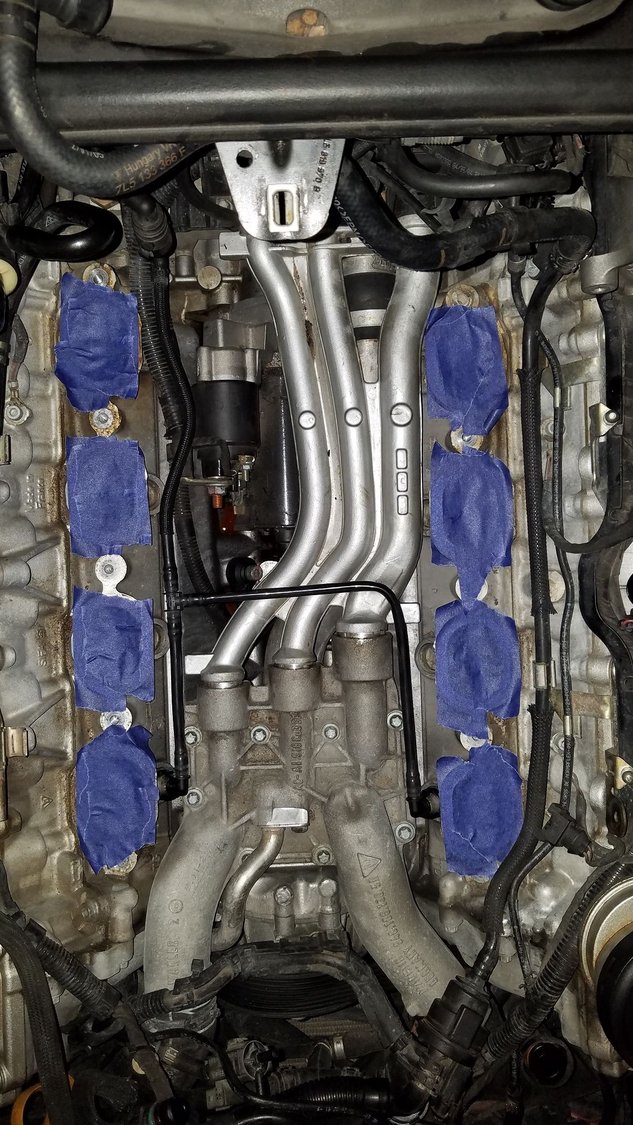
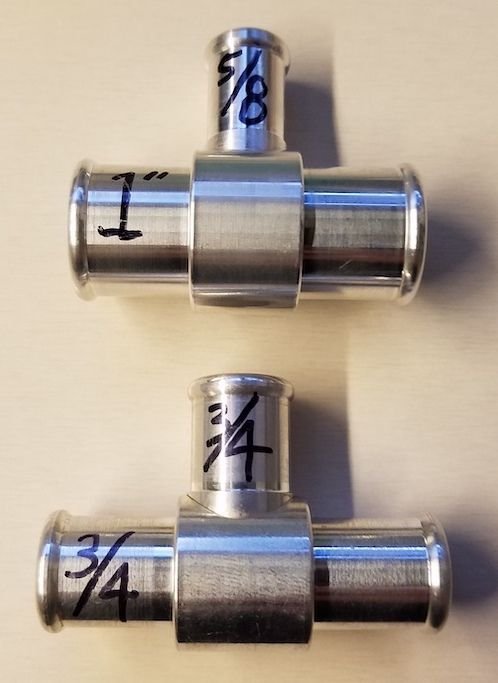
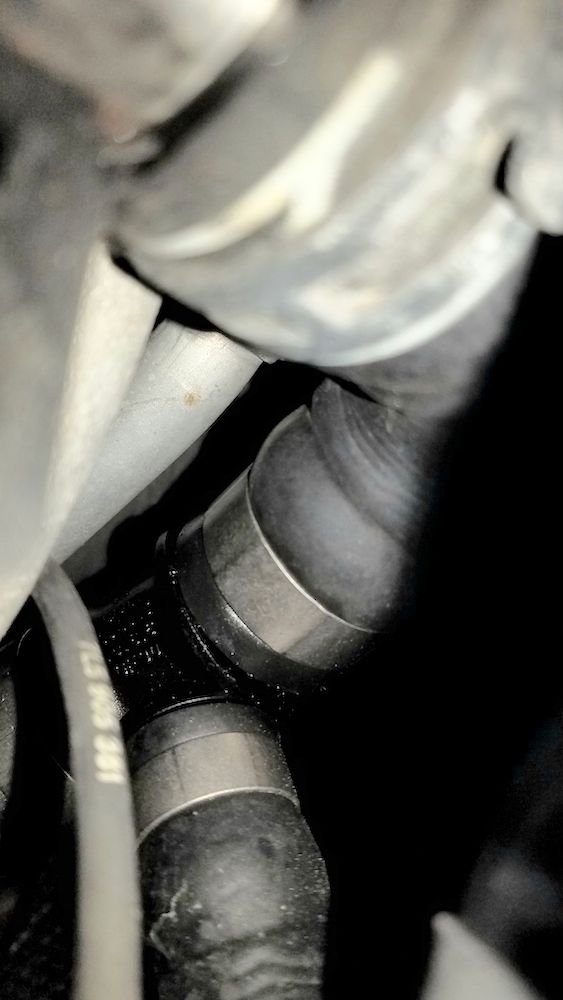
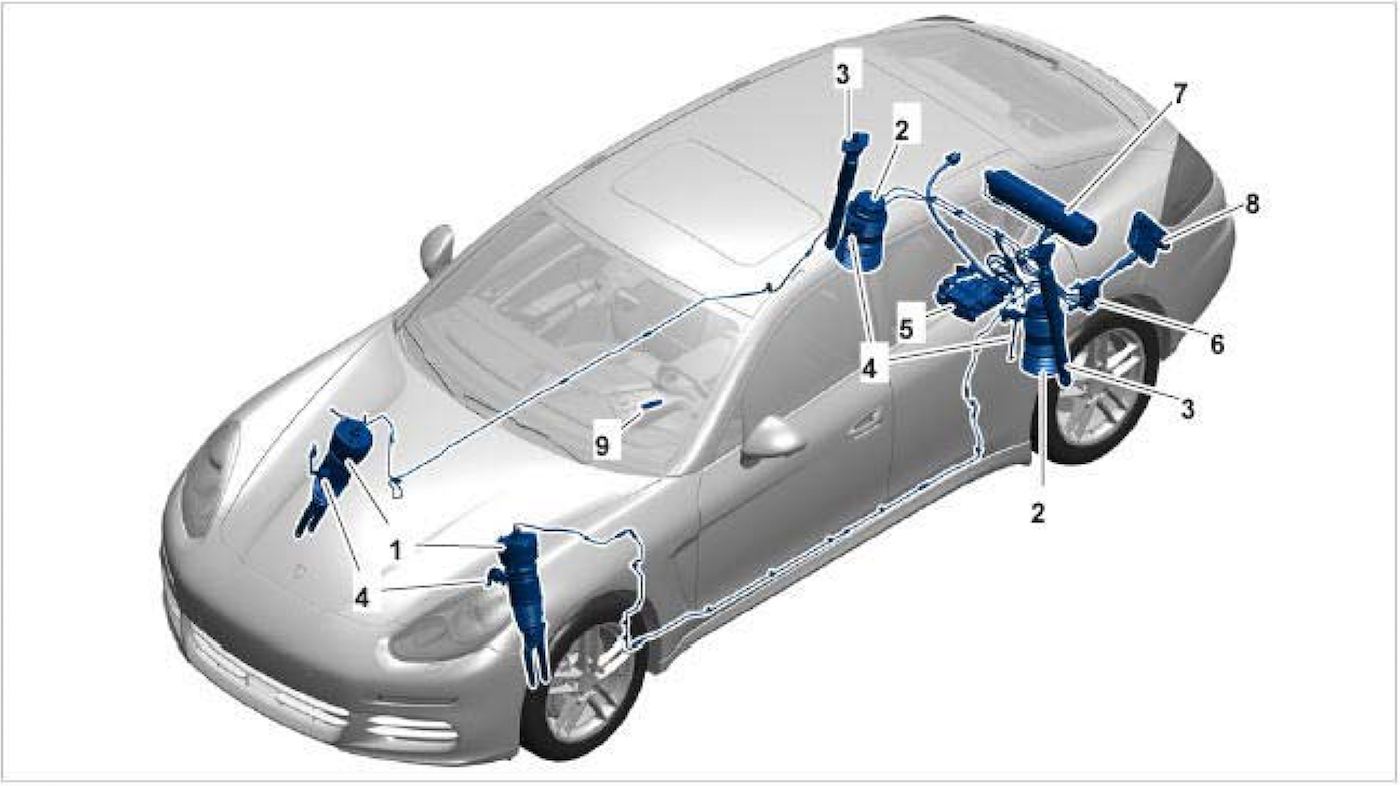
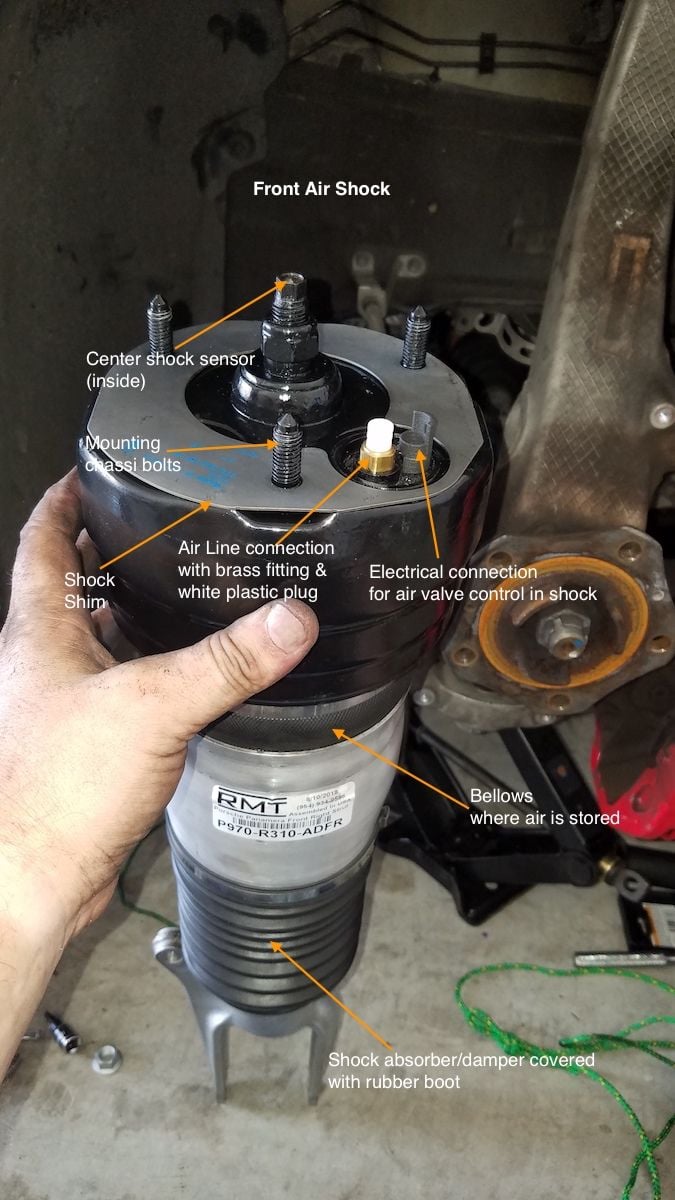
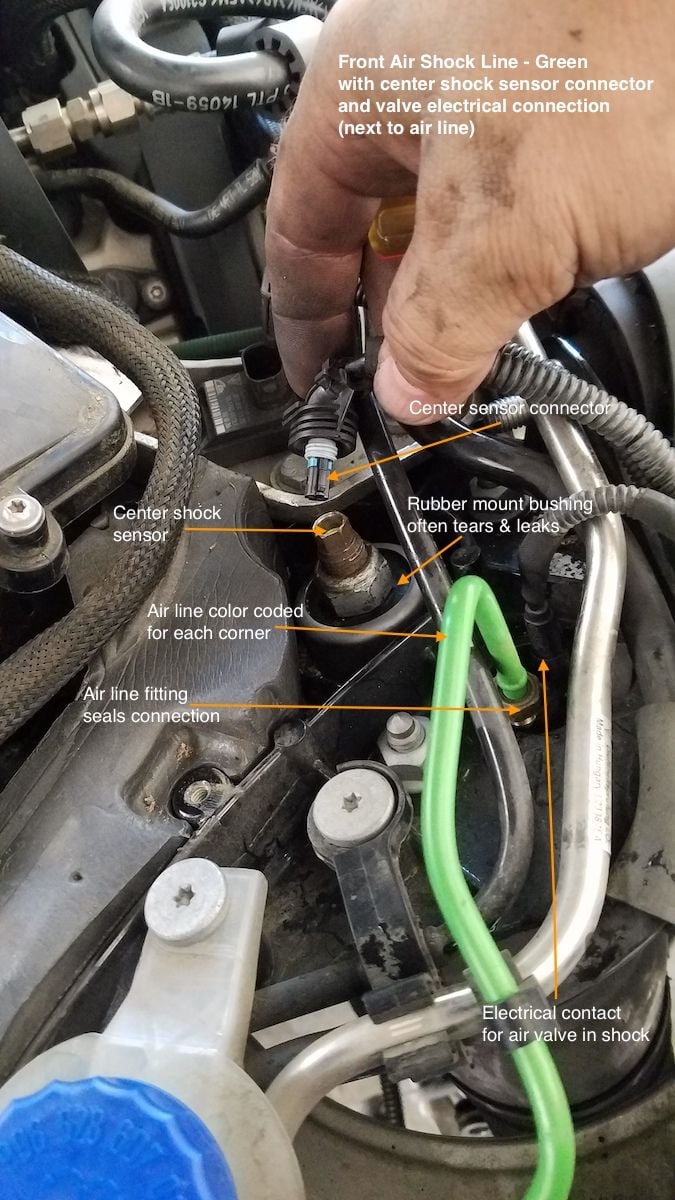
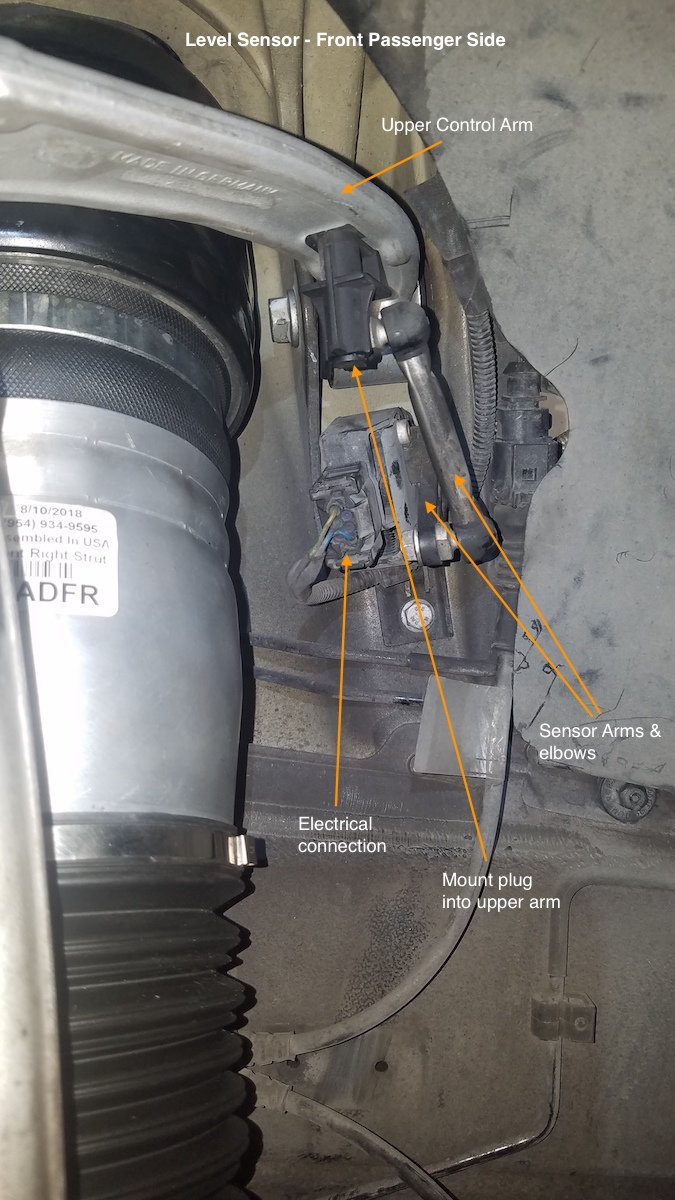

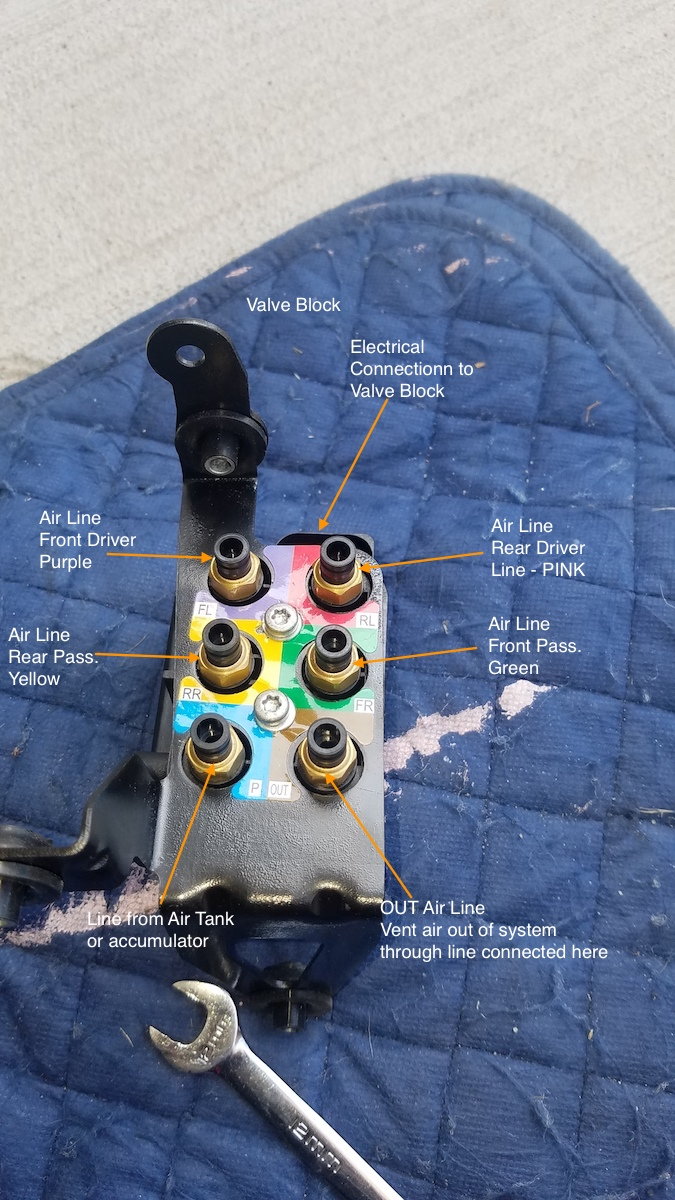
Removing intake and PD of coolant leak
in 9PA, 9PA1 (Cayenne, Cayenne S, Cayenne Turbo, Cayenne Turbo S)
Posted
Got that handles in another thread, just to wrap up.